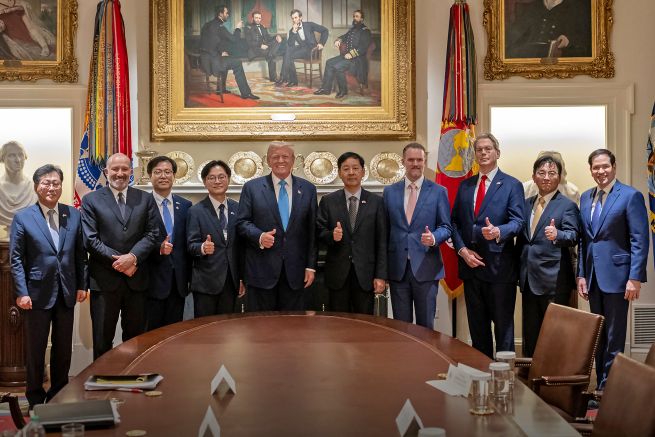
U.S. President Donald Trump poses for a group photo with the South Korean negotiation team at the White House in Washington, D.C., on July 30 (local time) after concluding a trade agreement. (Photo source: White House X account)
SEOUL, August 4 (Korea Bizwire) — South Korea’s recent breakthrough trade agreement with the United States—touted as a major diplomatic win—may offer temporary relief on tariffs but leaves the door open for further pressure from Washington on sensitive trade issues, experts warn.
The deal, struck on July 30, outlines a sweeping $450 billion investment and procurement package from Korea, including $350 billion in investments and $100 billion in U.S. goods purchases.
In return, the U.S. agreed to lower planned reciprocal tariffs on Korean exports from 25% to 15% and reduce existing 25% tariffs on Korean automobiles to the same level, effective August 1.
While the agreement staved off immediate escalation, analysts say it functions more as a framework than a final resolution. Key points of contention—particularly non-tariff barriers in agriculture and digital trade—remain unresolved and are likely to resurface.
Concerns intensified after President Donald Trump, now back in office, claimed on Truth Social that South Korea had “agreed to fully open its markets to U.S. products including cars, trucks, and agricultural goods.” White House Press Secretary Caroline Leavitt echoed the sentiment, stating Korea had committed to a “historic opening” of its market to American rice and autos.
Seoul swiftly pushed back. Senior officials including Deputy Prime Minister Koo Yoon-cheol and Trade Minister Kim Jung-kwan stressed that agricultural concessions—especially on politically sensitive items like rice and beef—were not part of the deal. “There was no discussion whatsoever about opening the rice market,” Koo told reporters in Washington on August 1.

During the Korea-U.S. trade negotiations on July 31, the South Korean government was assessed to have achieved partial success in the agricultural sector by preventing further market opening for rice and beef. The negotiation team reportedly presented photos from the 2008 candlelight protests against U.S. beef imports to illustrate the political and emotional sensitivity surrounding agricultural market liberalization in Korea. The photo shows a candlelight protest held in June 2008. (Yonhap)
South Korean officials interpret the U.S. statements as political messaging aimed at domestic audiences rather than factual descriptions of the agreement. Nonetheless, the gap in narratives underscores the fragile nature of the deal and the potential for renewed friction.
Observers warn that Washington may leverage upcoming forums—including the next U.S.-Korea summit—to reintroduce demands related to agriculture and other non-tariff barriers, including digital trade regulations and export restrictions on mapping data.
“There’s a real risk that the U.S. will continue pressing Korea for broader market openings,” said a South Korean trade official. “This agreement doesn’t resolve those tensions—it merely postpones them.”
Trade Negotiator Yeo Han-koo, who led the talks, acknowledged the uncertainty. “We’ve averted crisis for now, but we cannot relax. We must be ready for future tariff or non-tariff pressures,” he said upon returning to Seoul.
Koo added, “The devil is in the details. We need a clear, proactive strategy as we enter the next phase of negotiations.”
As Washington sharpens its focus on non-tariff barriers—including Korea’s proposed online platform law and Google’s mapping data restrictions—Seoul faces mounting pressure to balance its regulatory autonomy with trade stability. The outcome of the coming negotiations may determine whether the current truce becomes a lasting peace—or the prelude to a deeper confrontation.
M. H. Lee (mhlee@koreabizwire.com)
